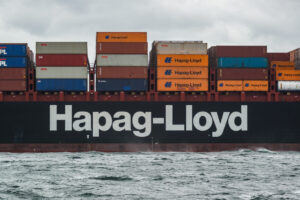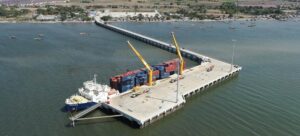Availability of green financing is set to hold many benefits for the port industry, particularly helping them achieve their sustainability goals, according to Drewry.
The port sector has been introducing new schemes and products recent years with the aim of becoming more environmentally friendly. These include electric powered vehicles and using green energy such as onshore power, which is an established strategy to reduce carbon emissions from berthed vessels in particular.
The schemes are especially needed in Europe where the European Union has set the aim to be climate neutral by 2050.
initiatives to reduce emissions associated with operations, remain a top priority for port authorities, terminal operators and other stakeholders. It is well established now that the main sources of emissions in ports include handling equipment, refrigerated cargoes, landslide transport, navigating, fuel consumption and construction.
Green Money
Green financing is an emerging funding option in the port sector which is set to help companies pay for these new Initiatives and implement them into their organisation to lower their carbon footprint.
“Our analysis shows green financing is gathering momentum in ship finance as the shipping industry aims for decarbonisation,” said Drewry Principal Consultant, Leticia Astudillo, during a 16 September webinar. “To some extent this is pushing the port industry to follow suit.”
Moving away from traditional sources of finance such as private financing (operating cashflow, corporate bonds, retained earnings) and government financing (state funding, grant funding, loan guarantee’s), green financing aims to provide benefits to a wider context than just the company.
“Green financing is an emerging source of finance where the cost of the financing is directly linked to specific ESG objectives laid out into terms of the financial agreement with independent monitoring to ensure compliance.”
Examples of this kind of funding include sustainability linked loans and sustainability linked bonds. Within the market there is a large competitive advantage for opting for green bonds due to the increased demand for ESG products.

“Green bonds are a higher cost to issue due to the increased levels of due diligence required at time of issuance, and the ongoing audit processes. However, the strong appetite in the market for green products typically results in over-subscription, which can reduce the overall cost of the debt to the borrower,” continued Astudillo.
It is expected that in the foreseeable future, mainstream sources of funding will incorporate elements of green finance into their terms and conditions. For example, lenders may require borrowers to address decarbonisation and other sustainability issues far more robustly as the financial sector strives to meets its own ESG goals.
However, investors and lenders still need to look beyond the green accreditation to ensure the underlying fundamentals of the port investment opportunity are still place. This is regardless of whether the initiative is green or not.
With the increased availability of green financing, it will no doubt become of a large benefit to the port sector. However, Drewry closed its webinar by saying it will not be a critical enabler for their decarbonisation initiative as the sector has already made enough progress without the need for any specific green finance products.









